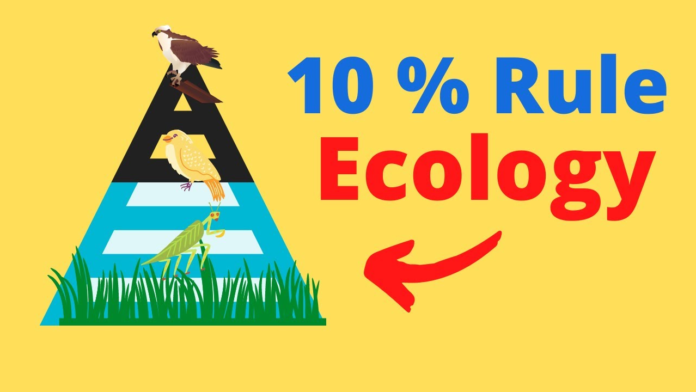Rule in ecology The ten Rule is an ecological rule of thumb that states for each 10 % improve in productiveness, there’s a corresponding 1 % lower in organic range. Ecologists and conservationists have lengthy used this rule to assist look at the potential impacts of human actions on earth’s ecosystems. By understanding what the ten Rule means, we are able to higher perceive how modifications in species composition or numbers can have an effect on ecosystems and develop applicable conservation methods. On this weblog entry, we are going to examine what precisely the ten Rule is and its implications for environmental sustainability.
What’s the 10 rule in ecology?
The ten rule in ecology is the precept that states that for each 10 % improve within the abundance of 1 species, there’s a corresponding 1 % lower within the amount of one other species. This rule is legitimate for numerous ecosystems and is without doubt one of the most vital ideas governing ecological interactions.
What are some examples of the ten guidelines in motion?
Briefly, the ten % rule states that in any given ecosystem, solely 10 % of the obtainable power is transferred to the subsequent trophic stage. For instance, in a grassland ecosystem, solely 10 % of the power from the solar that vegetation take up is transferred to herbivores (main customers). Of that 10 %, solely 10 % is moved to carnivores (secondary customers), and so forth up the meals chain. This power switch will not be one hundred pc environment friendly; some power is misplaced as warmth with every trophic switch.
Whereas the ten rule in ecology % rule is a useful instrument for understanding how power strikes via an ecosystem, it is important to keep in mind that there will be an excessive amount of selection in how a lot energy is transferred between trophic ranges. For instance, in some instances, greater than 50 % of power could also be misplaced between two tropics ranges. In different instances, lower than 1 % could also be handed on.
In ecology, the ten is arule in ecology that states that for every 10-fold improve within the variety of people in a inhabitants, there can be a 1-fold lower within the per capita fee of useful resource consumption. In different phrases, as a inhabitants grows, every particular person could have entry to fewer sources. This rule will be utilized to folks of any dimension, from small teams of animals to people.
One instance of the ten guidelines in motion is when a gaggle of animals is launched to a brand new setting. The bigger the group, the higher the competitors for sources and the extra probably it’s that some people is not going to survive. One other instance is when a inhabitants is confronted with a restricted meals provide. The bigger the variety of folks, the decrease the per capita fee of meals consumption and the extra probably it’s that some people will starve.
The ten rule additionally has vital implications for human populations. For instance, as our inhabitants grows and we devour extra sources, we’re placing growing stress on our planet’s finite sources. If we need to maintain our present stage of consumption, we have to discover methods to scale back our per capita useful resource use. In any other case, we are going to ultimately attain a degree the place our planet can now not help our inhabitants, and widespread hunger will happen.
How does the ten rule work?
In ecology, the ten rule is a straightforward idea that can be utilized to estimate the variety of totally different species in an ecosystem. The rule states that for each ten items of power obtainable in an ecosystem, 1-2 new species will develop. This rule will be utilized to any ecology research space, together with inhabitants dynamics, group interactions, and meals webs.
The ten rule is a results of ecological area of interest partitioning. That is when totally different species inside an ecosystem occupy totally different niches or areas to keep away from competitors. By doing this, every species can entry a extra significant slice of the obtainable sources, which results in extra profitable replica and better survival charges.
The ten rule in ecology is a useful instrument for ecologists as a result of it offers a method to estimate the potential variety of species in an ecosystem with out having to depend all of them immediately. Nevertheless, it’s important to remember that this rule in ecology is simply an estimation and that precise numbers might differ relying on the precise situations of an ecosystem.
In ecology, the ten rule in ecology method to perceive how power flows via an ecosystem. The rule in ecology states that 10% of the power obtainable at one trophic stage is transferred to the subsequent. For instance, main producers (vegetation) in a forest ecosystem use daylight to transform power into natural matter. This natural matter is then consumed by main customers (herbivores), that are, in flip, eaten by secondary customers (carnivores). Solely 10percentrule in ecology of the power obtainable to the first customers is transferred to the secondary customers.
This rule in ecology be used to know why there are usually fewer people at larger trophic ranges. Much less power is accessible at every progressive trophic stage as a result of a few of it’s misplaced as warmth throughout switch between trophic ranges. As well as, not all organisms are 100% environment friendly at changing power from one kind to a different. A few of the factors they devour are used for his or her metabolism and development, that means that there’s even much less obtainable to be handed on to the subsequent trophic stage.
What are the advantages of following the ten guidelines?
The ten rule is a straightforward guideline that may assist you to to keep up a wholesome ecosystem. By following this rule, you possibly can maintain your setting clear and pollution-free. Moreover, the ten guidelines will be sure that the entire sources in your ecosystem are used effectively.
Are there any drawbacks to the ten rule?
There are a few probably disadvantages to the ten rule in ecology. To begin with, it depends upon a small instance dimension of simply ten species. Second, the rule relies on empirical knowledge, which can solely be correct for some ecosystems. Third, the federal government must account for variations in productiveness between totally different ecosystems. Lastly, the rule doesn’t contemplate how human exercise can influence an ecosystem’s carrying capability.
There are a few attainable downsides to the ten rule. First, it’s primarily based on the belief that each one species are equally productive, which can be totally different. Second, the rule should contemplate how useful resource availability varies over time and area. Lastly, the ten administration might overestimate main productiveness in some ecosystems as a result of it wants to think about grazing by herbivores or different components that may scale back plant productiveness.
You Can Additionally See alegrianatural.co
What are some exceptions to the ten rule?
There are some exceptions to the ten rule. The primary exception is when there’s a change within the setting, comparable to a change in temperature or the quantity of meals obtainable. The second exception is when there’s a change within the inhabitants dimension. The third exception is when there’s a change within the inhabitants’s genetic make-up.
Conclusion
The ten Rule is a vital idea in ecology, and understanding it may well assist us make higher selections when managing our ecosystems. This rule reminds us that the variety of people an ecosystem can help depends upon their power supply, availability of sources, and environmental situations. By observing this rule and making sustainable decisions inside our surroundings, we are able to be sure that nature will have the ability to thrive and stay wholesome for years to come back.













